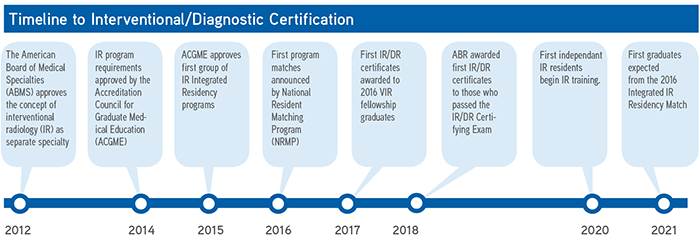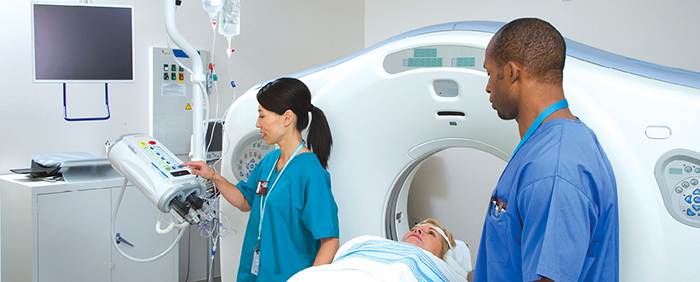Interventional Radiology Progresses as New ABR Specialty
One year in, read how IR is making gains as a unique specialty.
BY MIKE BASSETT
August 01, 2018

Kaufman
Nearly a year after the first interventional radiology/diagnostic radiology (IR/DR) certificates were issued by the American Board of Radiology (ABR), IR is making impressive gains as a unique specialty with its own distinct residency program.
In fact, the ABR certification — many years in the making — represents the future of IR, leaders say.
“We are truly now in the new era for IR/DR in terms of the certification and exam process,” said John A. Kaufman, MD, MS, chair of the Department of Interventional Radiology and director of the Dotter Interventional Institute at the Oregon Health & Science University in Portland and past chair of the ABR-Society of Interventional Radiology (SIR) Primary Certificate Task Force.
IR is one of four primary certificates offered by the ABR, along with diagnostic radiology, radiation oncology and medical physics.
To date, ABR has awarded IR/DR certificates by examination to 264 individuals who passed the first IR/DR certifying exam in October 2017. The second class of candidates is gearing up for the next IR/DR certifying exams to be held in October, 2018, in Tucson.
And as of May 2018, 78 institutions have received the Accreditation Council for Graduate Medical Education (ACGME) accreditation of their integrated IR residency programs. The ACGME will review more program applications at its October 2018 meeting.

Opportunity to Convert to IR/DR Certificate
The ABR approved the IR/DR certificate to recognize IR as a unique medical specialty in 2012 and the ACGME approved the first group of IR Integrated Residency programs in November 2015.After issuing the final Vascular and Interventional Radiology (VIR) subspecialty certificate in 2016, the ABR last October offered physicians who held DR primary certification, as well as VIR subspecialty certification, the opportunity to convert to the new IR/DR primary certificate.
Of the 2,679 individuals who were eligible to convert to the new specialty certificate, 2,601 had completed the process as of press time. Those who did not convert to the new certificate primarily either do not practice IR or are nearing retirement, ABR officials said.
The ABR has also approved a temporary policy creating an IR/DR transition pathway for radiologists who completed an ACGME-accredited VIR fellowship 10 or more years ago but never pursued or earned a VIR subspecialty certificate.
According to ABR leaders, this has been one of the “hot topics” surrounding the creation of the new IR/DR certificate.

Laszakovits
“These individuals are not eligible for IR/DR certification within our conversion rules,” said David Laszakovits, MBA, director of external relations for the ABR. “The existence of the IR/DR certificate is the reason that the ABR must make all VIR subspecialty certificates inactive. The American Board of Medical Specialties will not permit there to be two separate certificates offered by one board for a single discipline because it would be confusing to the public.”
The ABR issued the last VIR subspecialty certificate in 2016. Beginning this year, those physicians certified in DR or general radiology who completed an ACGME-accredited fellowship more than 10 years ago, but were not certified in VIR, are eligible to take the oral component of the IR/DR certifying exam. If successful, those individuals will be awarded a continuous ABR specialty certificate in IR/DR.
This pathway is only available for a limited time, with applications being accepted until April 30, 2020. Dr. Kaufman suggests that those eligible and interested should act as quickly as possible.
“There are only three opportunities to this,” Dr. Kaufman said, noting that if an eligible radiologist waits until 2020 to take the qualifying exam and fails, the transition pathway closes. “Then those individuals have to go through the whole formal re-entry process, which includes a year of training, or two years on faculty in full-time interventional radiology.”
In addition, the International Medical Graduates Alternate Pathway — through which international medical graduates must satisfy a number of requirements to be considered as a candidate for ABR certification — has been extended to IR/DR certification.
“The board is really trying to make this available to individuals who trained in other countries,” Dr. Kaufman said. “It will give them a way to get their certificate without having to repeat all their training.”

DR Certification Status After IR/DR Conversion
Converting to the new IR/DR specialty certificate has not been without contention, specifically among some individuals who hold lifetime DR certificates,“When someone with a Diagnostic Radiology certificate earns an IR/DR certificate, we sunset, or don’t display, the Diagnostic Radiology certificate, and that’s where some confusion occurred in the lifetime certificate holder group,” Laszakovits said.
Those individuals, noting that the IR/DR certificate is not a lifetime certificate, were concerned that they might never get that lifetime DR certificate back if they decided they no longer wanted to practice IR.
Those concerns are unfounded, Laszakovits said.
“If somebody who had a lifetime diagnostic radiology certificate converted to an IR/DR certificate and at some point in the future — for whatever reason — decides they no longer want to be certified in IR, just let us know. We’ll discontinue their IR/DR certificate and reissue and redisplay their lifetime diagnostic radiology certificate.”
IR Zone Planned for RSNA 2018
New for RSNA 2018, RSNA will feature a dedicated area for exhibitors with a focus on interventional radiology (IR). Located in the South Hall adjacent to the First Time Exhibitor Pavilion, the IR Zone will make it easier for interventional radiologists to locate and interact with companies offering products specific to their subspecialty.